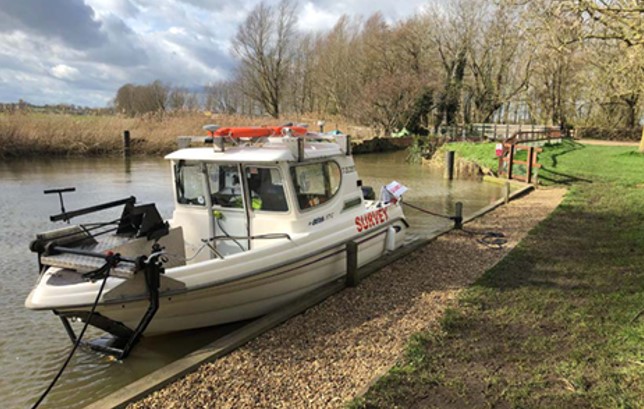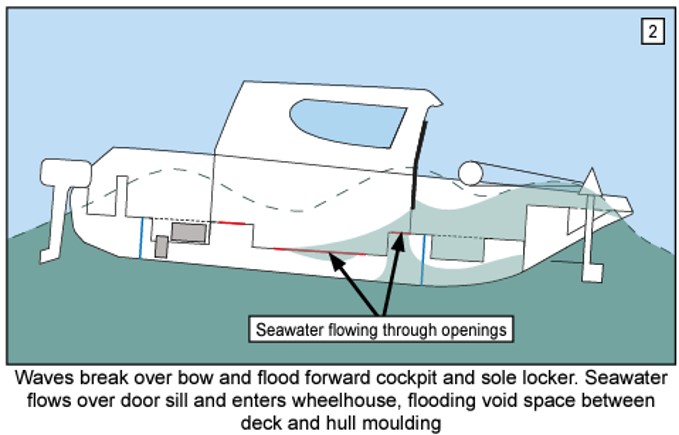MAIB: Flooding and sinking of the survey workboat Bella
The UK Marine Accident Investigation Branch has published Report 10/22 into the flooding and sinking of the survey workboat Bella. The boat flooded and sank while carrying out hydrographic survey operations in coastal waters. The crew abandoned into the life raft and were rescued uninjured by a local boat owner; there was no pollution.
The full document contains much detail of interest to members who operate small boats, including some informative diagrams and illustrations, which for the sake of brevity has to be omitted here.
What happened
The survey workboat was conducting inshore hydrographic survey operations in the approaches to Lynmouth, UK. In conditions of wind force 3 from the NW, and short, choppy 1m seas, waves started breaking over the bow, beginning to fill the forward cockpit area. The skipper turned on the electric bilge pump and reversed course to the south-east in an attempt to prevent further water ingress by running down-sea. Floodwater was, by then, flowing over the sill of the forward door into the wheelhouse and from there entered the void space beneath the wheelhouse deck.
With the boat sitting low in the water, bow down, the skipper realised that there was a danger of sinking so he stopped the engine and told the crew member to make a “Mayday!” call using the hand-held VHF radio. No response was heard to the VHF “Mayday!” call, so the crew member used a mobile phone to call the emergency services to notify the coastguard. Shortly after the emergency calls were made, and with the boat swamped and partly submerged, the skipper launched and manually inflated the life raft. As the boat was sinking, the skipper and crew member entered the sea and scrambled into the inflated life raft. Both were rescued shortly thereafter and were unharmed. Two weeks later, divers located and salvaged the sunken boat.


What went wrong
- This was a small open boat primarily designed for recreational use;
- She had been significantly modified for commercial surveying by the addition of a heavy gantry, winch and multibeam echo sounder. These modifications had reduced the boat’s forward freeboard, increasing its vulnerability to flooding;
- In moderate seas, Bella shipped water over the bow that made its way into the wheelhouse and then into the void space between the deck and the hull. With no buoyant volume or in-built buoyancy, the boat was soon overcome and sank;
- Investigation identified weaknesses:
- In the commercial certification applicable to the boat, which resulted in it being inappropriately certified as a workboat suitable for operations at sea, and,
- In the owner’s safety management system.
What was the cause
- The boat sank because it became swamped with seawater and had insufficient reserves of buoyancy or means of flotation to remain afloat;
- The vessel was vulnerable to swamping even in moderate sea conditions because the addition of the multibeam echo sounder gantry had significantly reduced its forward freeboard;
- Despite being issued with the necessary certification, the boat was not compliant with the Workboat Code; shortcomings in construction and means of flotation were missed during the certifying survey due to the surveyor’s over-reliance on RCD documentation;
- The shore-based team almost certainly underestimated the risk flooding and swamping as they had no recent experience of operating in the open sea and had become accustomed to operating in sheltered waters with low sea states;
- The operator’s operations manual was not an effective safety management system; shortcomings included underestimation of hazards associated with vessel modifications, operating conditions and crew qualifications;
What went right
- The two crew managed the emergency creditably and were fortunate to be rescued by local vessels soon after their boat sank. The wearing of PFDs and their familiarity with lifesaving equipment led to a safe and orderly abandonment.
Members may wish to refer to:
Safety Event
Published: 23 November 2022
Download: IMCA SF 26/22
IMCA Safety Flashes
Submit a Report
IMCA Safety Flashes summarise key safety matters and incidents, allowing lessons to be more easily learnt for the benefit of all. The effectiveness of the IMCA Safety Flash system depends on Members sharing information and so avoiding repeat incidents. Please consider adding [email protected] to your internal distribution list for safety alerts or manually submitting information on incidents you consider may be relevant. All information is anonymised or sanitised, as appropriate.
IMCA’s store terms and conditions (https://www.imca-int.com/legal-notices/terms/) apply to all downloads from IMCA’s website, including this document.
IMCA makes every effort to ensure the accuracy and reliability of the data contained in the documents it publishes, but IMCA shall not be liable for any guidance and/or recommendation and/or statement herein contained. The information contained in this document does not fulfil or replace any individual’s or Member's legal, regulatory or other duties or obligations in respect of their operations. Individuals and Members remain solely responsible for the safe, lawful and proper conduct of their operations.
